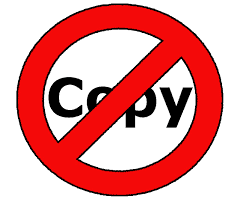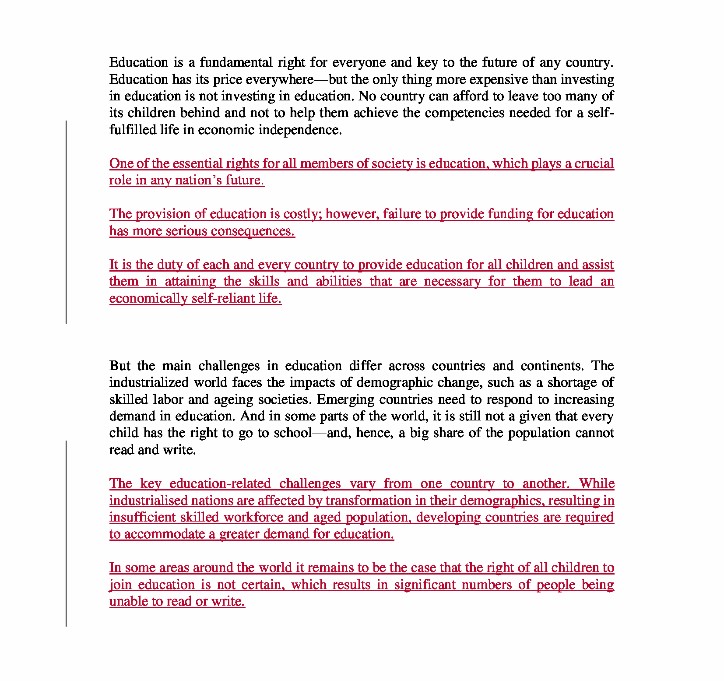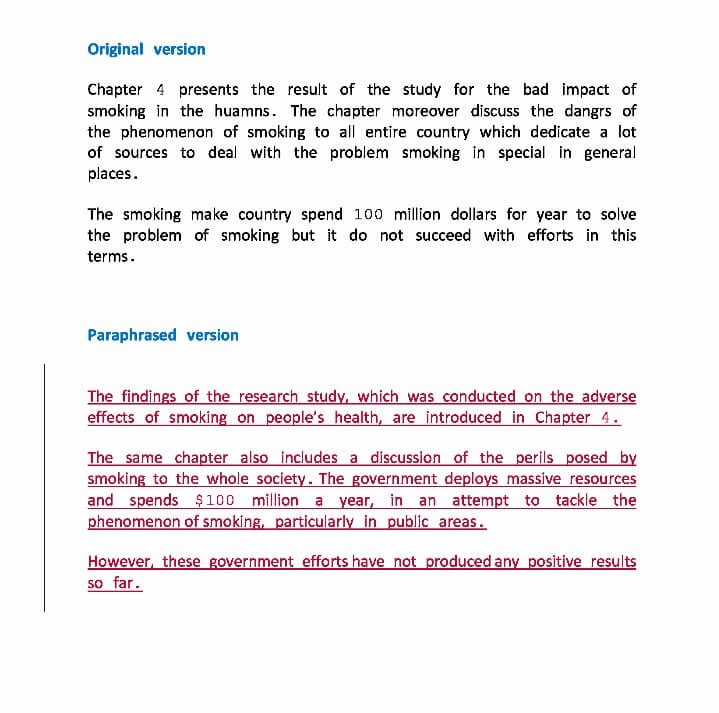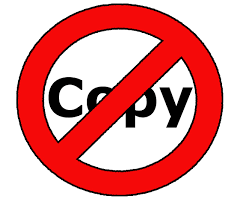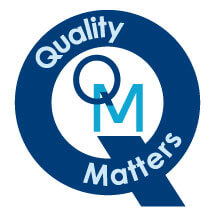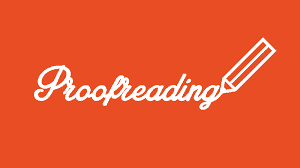- Home
-
For Academics
- In-depth Dissertation Proofreading & Editing Service
- Advanced Essay Proofreading Service
- Paraphrasing Services
- Journal Article Proofreading & Editing
- Text Reduction Service
- Proofreading Research Proposals
- Thesis & Dissertation Formatting
- Practical tips on dissertation writing
- Writing a thesis abstract
- Writing a thesis statement
- For Book Authors
-
For Businesses
- Business Proofreading Service
- Business Editing Service
- Business Substantive Copy-editing
- Legal Proofreading Services
- Proofreading Services for Freelance Journalists
- Copyediting & Proofreading Services for Professionals
- Proofreading Services for PR & Marketing Firms
- Proofreading & Editing for Translation Companies
- Proofreading Resources
- About us
- English language blog
Paraphrasing Services UK - Manual & Affordable
Rewrite your academic paper manually by human paraphrasers to ensure it passes even the most sophisticated plagiarism checkers. 100% customer satisfaction guaranteed. Submit your document here.
Manual Paraphrasing Services UK - 24/7
The Ultimate Proofreader provides a unique paraphrasing service, done manually by human paraphrasers and rewriters from start to end. We DO NOT use any online paraphrasing or rewriting tools or software in our paraphrasing service – as other service providers do.
Minimal similarity
We will reduce similarity with the original text to an absolute minimum so that your paper can pass the plagiarism detection software Turnitin successfully.
As the UK's No. 1 academic paraphrasing services provider, we guarantee 100% that your academic paper will be rewritten and reworded professionally to the highest academic standard.
Expert paraphrasers
Fast & Affordable
Ready to place a paraphrasing service order, want an instante quote or need a free paraphrasing sample? Get in touch with us now.
Five reasons to choose our rewriting/paraphrasing service
1. Specialism
We have been delivering rewriting and paraphrasing services of excellent quality for many years – which has made us the leading and trusted provider in the UK, the US and around the world. We are the market leader in the rewriting/paraphrasing service industry.
2. Human paraphrasers
We use only actual human paraphrasers and never use any robots or online software to paraphrase and rewrite your text.
In fact, we have been warning against companies that offer instant and super-fast paraphrasing services because they simply provide a flawed and poor quality paraphrasing service using software.
Rewriting a text in a different style using a different language and structure while protecting the original meaning is a job for human brains – not for machines.
3. Language expertise
Our academic text rewriters and editors are all native English speakers with degrees from the world's best universities. Our paraphrasers never use informal expressions, awkward grammar, or non-academic language. Nor do they mix American English with British English, or produce inaccuracies while paraphrasing your document.
4. Text digesting
Our paraphrasers look at the heart and soul of your text while paraphrasing or rewriting it.
In other words, our rewriters do not just change a word for word, or a sentence for sentence, in a mechanical way. They first read through your the entire text to fully digest and understand its meaning before starting to paraphrase or re-word your academic manuscript.
5. Making sense
Clarity in academic writing is extremely vital. This means that, for us, every single word and every single sentence in the text must make sense. If ever in doubt, we check with you as to what you intended to say, in order to ensure we deliver a paraphrased version that is immaculate and where every word and sentence makes perfect sense. If your text is inarticulate or not comprehensible in some places, our rewriters will leave you comments and questions as appropriate.
How to place an order - from A to Z
Ordering our paraphrasing service is extremely easy:
Sending
So, if you have an essay or any other academic text and would like to place an order for our Paraphrasing Service, please follow the following steps.
- 1) Send us the document by email to [email protected]. We work on both word (preferred) and PDF formats;
- 2) Specify in your email your preferred deadline;
- 3) If you have any specific requirements or instructions, please highlight them in your email.
Alternatively, your can upload your document through the form available on our website.
Confirmation
Within two hours or less, we will get back to you with:
1) Confirmation of receipt and availability
2) Delivery details
3) Payment details (we accept payment via PayPal or bank transfer). PayPal is preferred. Once payment has been made, the job will be assigned to a text paraphraser, and it is all done.
Note: You do not need to have a PayPal account to make the payment.
Delivery
You will get your document back from us within your preferred deadline by email. You will receive a clean final version that is ready for immediate use and submission.
Along with the document, your will also receive (if applicable):
- Paraphraser’s notes
Paraphrasing Service: Sample 1
Paraphrasing Service: Sample 2
Why paraphrasing service matters?
While writing your dissertation or thesis, as an MA & PhD student, researcher or academic, you often have to cite from other studies or research papers in the literature review section of your dissertation or thesis.
If you are not well versed in English or do not have the required creative ability to expertly convert the original text, using your own words, you are then at risk of falling into the trap of plagiarism – which is an extremely serious crime in academia.
It is now extremely easy to detect lifted or plagiarised content in any piece of academic writing, thanks to advanced technology and availability of detection software tools, such as Turnitin – which is used by the majority of universities to detect plagiarism.
This explains why rewriting or paraphrasing services are highly important. As a paraphrasing service UK provider, we offer an outstanding rewriting service – a 100% customer satisfaction is guaranteed.
Our expert text rewriters and editors, with their many years of experience, will get your text academically rewritten, and above all plagiarism-free to ensure it passes the Turnitin test successfully.
Also, to make things easier for you, we always do a small free-of-charge sample of your writing first, in order to give you an opportunity to see our quality and compare it with that of any other service provider.
You can email us any 100 words of your text to [email protected].
We aim to return completed samples to potential clients within 12 to 24 hours maximum, subject to availability.
How to choose a paraphrasing service provider?
We often receive requests from MA & PhD students and academics asking us to provide them with a professional paraphrasing service after they had been disappointed with the quality of other service providers.
As a genuinely professional and expert paraphrasing service provider, we can perfectly understand how and why things went wrong for them.
First: Wrong choice
The first and key mistake is simply that they had chosen the wrong service provider. They might have been misled by all flowery and eloquent language used by those providers in their description of their services.
Second: Failure to compare
Almost all paraphrasing service providers offer clients, particularly new ones, a free sample option. Basically, any student or academic keen to make the right choice should take advantage of this offer.
The more samples you get from providers the better because it will help you compare them all against a certain number of criteria (quality, speed, cost). If you are dealing with a provider for the first time, it is always best to test them first through the free sample option. Failure to do quite often results in disappointment.
Third: Source of problem
The poor quality of a paraphrasing services is certainly the result of a lack of knowledge about the art of paraphrasing.
Paraphrasing is not about replacing one word with another or replacing one sentence with another using synonyms. It is more about a full grasp of the original text, digesting it and then converting it using a different style, structure, terminology and tone.
Unfortunately, many clients complain that providers they had tried gave them a paraphrased version that was easily detected as plagiarised. Detecting lifted or plagiarised content has never been easier, thanks to available pieces of software such as Turnitin.
So, our advice to students and academics who are after a professional paraphrasing service is to make your research well about the best provider, test as many providers as you can and then compare the quality of their service. Only then you can rest assured that you have made the right choice.
The Ultimate Proofreader is the UK's best dissertation proofreading services provider.
Who are we?
When first launched, the Ultimate Proofreader was a thesis proofreading service.
But soon after, we responded to the market need and introduced our professional paraphrasing service, which today is one of the most popular academic language services we provide to students, researchers, postgraduates and academics in the UK, the US, Malaysia, China, Saudi Arabia and other countries. This is in addition to our advanced essay services.
Rewriting or paraphrasing a text is not a job; it is an art which we have been able to master.
And it is for this reason that the Ultimate Proofreader today stands out from the crowd with its matchless paraphrasing service. We have successfully built a good reputation as a highly trusted, professional and specialist paraphrasing service provider.
Our success is owed to our experienced and excellent team of paraphrasers, rewriters and editors who help us deliver such a sterling paraphrasing and rewriting service to clients in various UK universities such as the University of Cambridge, the University of Oxford, the University of Leeds, the University of Reading, the University of Sheffield, among others.
We are very popular among students and academics, not only because of the top quality of our service, but also because of our simplified and transparent pricing structure.
Aware of how students and postgraduates can be running on a very tight budget, particularly with the high cost of education in the UK, we offer our rewriting & paraphrasing service at very competitive and affordable prices.
Unlike other providers, we charge our clients on the basis of the word count, not per hour. Charging clients per hour can be very costly for them, because some assignments can be complex and more difficult to paraphrase and rewrite than others, especially if your academic text is full of technical, medical or engineering expressions and terminology.
We pride ourselves on adding an extra layer of scrutiny to our personalised paraphrasing service, which is hardly done by any other paraphrasing service provider: once the text has been rewritten and reworded by our paraphrasing expert, it is then sent to an editor who runs through it entirely to ensure that it does not have any language flaws or errors.
The reason why we do so is that we highly respect the trust that our loyal clients put in us.
We also love to interact with our clients and are available to assist them with any enquiries, instructions or comments, whether before, during or after the completion of the paraphrasing assignment.
We can be reached 24/7 by email ([email protected]), or by phone (07717750188).
* Find out more about why we are the preferred paraphrasing service provider for thousands of students and academics in the UK & across the world.
Testimonials
"I just want to say thanks so much for the manual paraphrasing service. You helped me a lot. The similarity is only 2% which is a WOW," Dina, a PhD student from Saudi Arabia.
"Thanks, great work! May I submit other documents I have for the paraphrasing service, please," Jack, a PhD student.
"Thank you very much for your quick reply and turnaround of my document. The essay rewriter who paraphrased my paper is excellent. I also really liked the proofreading services you provide. Great help." Ahmed, a PhD student from Malaysia.
"It went so well with my supervisor, im so grateful for you help. Your paraphrasing service is really great," Mary, a researcher from UK.
" In addition to their dissertation proofreading services uk, I found their paraphrasing service really excellent," Adel, a researcher from Saudi Arabia.
"The Ultimate Proofreader team are very keen on customer satisfaction. They are definitely one of the best rewording services providers in the UK," Mohamed, from UK.
Paraphrasing for businesses & companies
We have launched a brand new paraphrasing and rewriting service for businesses and companies.
If you would like to give your website content a fresh look to attract clients and have a greater impact on your website visitors, just get in touch with us and we will pair your document/text with a specialist business text paraphraser/rewriter.
If you have a report or company material that needs to be rewritten professionally, we are here to help.
This paraphrasing service is a great value for money.
Do not hesitate to contact us if you have any enquiry or would like to find out more about this newly launched paraphrasing service.

